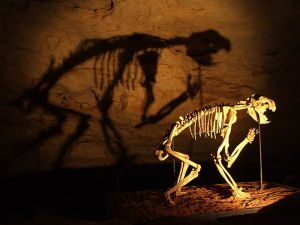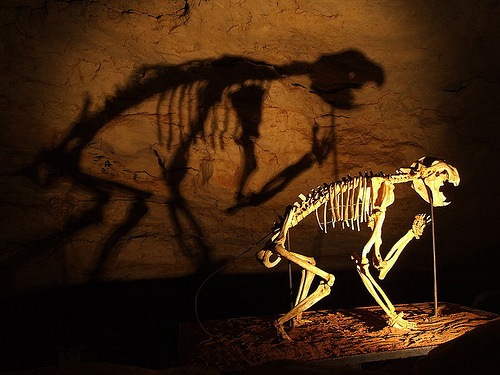
SOCIETY OF VERTEBRATE PALEONTOLOGY—While the anthropogenic impact on global species diversity is clear, the role of ancient human populations in causing extinctions is more controversial. New data presented at the Society of Vertebrate Paleontology meetings in Dallas, Texas, implicates early humans in the extinction of large mammals, birds and lizards in Australia. More precise dating of these extinction events places them 10 thousand years after the first arrival of humans in Australia, suggesting human predation was the most likely cause.
Australia was once home to a plethora of large-bodied animals, including a huge monitor lizard, large terrestrial birds, a giant wombat, the marsupial lion, and giant kangaroos. Sometime during the last ice age this once-abundant ‘megafauna’ disappeared. Though this extinction roughly coincides with the first arrival of humans to Australia, their direct role has been hotly debated, as some research has claimed that humans arrived after some of the animals were already extinct.
To shed light on this controversial issue, paleontologist John Alroy, of Macquarie University, New South Wales, and colleagues, set out to more precisely estimate the timing of the Australian megafaunal extinctions. Alroy explains “There’s been a lengthy, sometimes heated debate about whether human hunting or other impacts caused the huge mass extinction of large terrestrial vertebrates in Australia during the last glacial period.”
______________________________________________
Reconstruction of an extinct marsupial lion within the Victoria Cave in Australia. Wikimedia Commons
______________________________________________
Alroy dated over 200 fossils by measuring the levels of radioactive carbon in their bones. Precisely estimating when a species went extinct is difficult because there are gaps in the fossil record. To overcome this problem, Alroy estimated the likely time-range during which the extinction occurred based on the age of the most recent fossil. He found that the megafauna disappeared between 27 and 40 thousand years ago. Using a similar method, he estimated that the first humans arrived between 50 and 61 thousand years ago. This confidently puts humans on Australia when the megafaunal extinctions occurred.
The timings also suggest that there was a ten thousand year lag between the first appearance of humans and their impact on the megafauna. Alroy and colleagues suggest that this delay could relate to the time taken for humans to spread across Australia, or for the technology of early populations to advance enough to hunt large prey.
These findings not only highlight the long-term impact of humans in Australia, but also support patterns seen elsewhere, explains Alroy, “The results are also important because they’re consistent with evidence that human hunting caused major extinctions later on in North and South America, in addition to relatively recent extinctions on many islands (such as the loss of moas in New Zealand).”
_____________________________________________________________
Source: Press release of the Society of Vertebrate Paleontology
_____________________________________________________________
In addition, the latest Popular Archaeology ebook is now available.
______________________________________________
Travel and learn with Far Horizons.
____________________________________________
This richly illustrated issue includes the following stories: Two remarkable discoveries that are shedding light on human beginnings in Africa; a traveling exhibit and an archaeological site that show how knowledge is more valuable than gold; a Spanish cave and a unique burial that are offering a tantalizing glimpse on the lives of Ice Age hunter-gatherers in Europe; the stunning visual reconstruction of an ancient Roman town; enlightening new finds at a remarkably well-preserved site of ancient Hellenistic-Roman culture overlooking the Sea of Galilee; rare finds that are shedding light on occult practices among ancient Greeks in Sicily; and an overview of the overwhelmingly rich archaeological heritage of Britain. Find it on Amazon.com.









